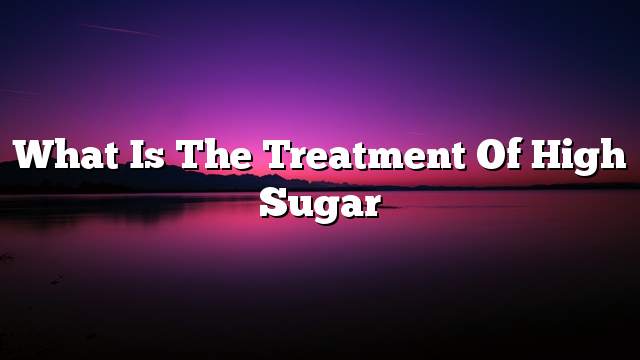High sugar
High sugar occurs when there are large amounts of glucose in the blood because of the inability of the body to use properly, and this increase is caused by the presence of diabetes, a health problem that will last for life. There are two types of diabetes: Type 1 diabetes, an autoimmune disease that occurs when the body attacks the cells producing insulin in the pancreas and break it, leading to the lack of secretion of the hormone insulin completely, and this hormone in the normal mode to transfer glucose from Blood to the cells of the body to be used as a source of energy, and there is no scientific explanation for the cause of the occurrence of this problem, it is worth mentioning that the system of life or the nature of food does not affect the possibility of occurrence, Type II diabetes, where the body does not release quantities Insulin is sufficient or insulin-free The excreted insulin is not as effective as it should be, which causes the accumulation of glucose in the blood, caused by genetic factors as well as environmental factors, and can be delayed by a healthy lifestyle.
Non – pharmacological treatment for high sugar
Glucose readings in the blood can be reduced by exercise, but it is important to make sure that there are no Ketones in exercise because this will lead to a higher glucose readings, and this should be ascertained when blood glucose readings are increased About two hundred and forty milligrams per deciliter. Reducing the amount of food consumed in blood sugar reduction should be reviewed. A dietitian should be consulted to develop a proper diet. In cases where you do not respond to exercise and diet, your doctor will have to modify the medication you are taking. Weight loss may help control or reduce the risk of type 2 diabetes. Type 2 diabetes is heavily linked to weight, and weight reduction surgery can be used as a last resort in cases where other methods of weight loss do not respond. .
Drug therapy for high sugar
Some oral medications are used to reduce blood sugar. These drugs include:
- Biguanides: Reduces liver secretion of glucose, reduces gastrointestinal absorption of glucose, and increases the sensitivity of the body’s cells to insulin, including metformin.
- Sulfonylureas: Increases insulin secretion of beta cells in the pancreas, reduces liver production of glucose, and increases the sensitivity of insulin receptors in target peripheral cells.
- Thiazolidinediones: These compounds increase the sensitivity of insulin receptors and affect the production of the gene involved in the metabolic processes of glucose and lipids. Their mechanisms depend on the presence of insulin for its effectiveness.
- Alpha-glucosidase inhibitors: These compounds prevent the enzyme in the digestive system responsible for converting starch compounds and complex sugars into simple sugars that can be absorbed.
Industrial insulin can be used to control blood sugar, which is used in the form of syringe or prepackaged pen, inhaled insulin, and others. The highest level of insulin absorption when injected into the abdomen, and there are four types of synthetic insulin, which is instant insulin (Rapid-acting insulin), which begins in a few minutes and lasts for several hours, and regular insulin-regular (short-acting insulin) , Requires about 30 minutes to achieve full effectiveness and lasts from three to six hours, and insulin medium-acting (Intermediate-acting insulin), and it takes two hours to four hours to achieve full effectiveness, and can last up to eight hours, and the latter type is Insulin is slow For (in English: Long-acting insulin), where the effectiveness of this type will continue throughout the day, and supports the frequency and timing of taking insulin on the type used.
Symptoms of high sugar
Symptoms of hyperglycemia appear slowly over several days or weeks, but they usually only begin to appear when blood glucose levels rise significantly; when their blood concentration reaches 200 milligrams per deciliter or more. The higher the glucose readings, The more serious the symptoms. The initial symptoms that appear and help to start solving the problem immediately are frequent urination, increased thirst, blurred vision, general tiredness, tiredness, and headaches. When hyperglycemia rises and is not treated, and the accumulation of some toxic acids in the blood and urine such as ketones, late symptoms of hyperglycemia include a fruit-like odor of breath, nausea, vomiting, shortness of breath, dry mouth, abdominal pain and coma : Coma), and others. It should be noted that some people with type 2 diabetes show no symptoms except high blood glucose readings.
Laboratory tests for high sugar
The measurement of blood sugar helps control high blood sugar. According to the World Health Organization (WHO), blood glucose readings are higher than one hundred and twenty-six milligrams per deciliter after fasting, or more than 200 milligrams per deciliter after two hours of mealtime. Maintaining the correct level of blood sugar (HbA1c) in preventing and reducing the likelihood of complications of diabetes. It is important to know that diabetics are more likely to increase cholesterol in an unhealthy way. Diabetes contributes to the reduction of high-density lipoprotein and low-density lipoprotein, And triglycerides, which increases the risk of cardiovascular disease.
